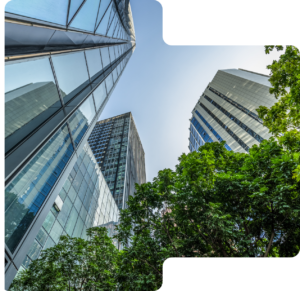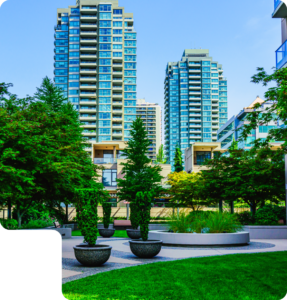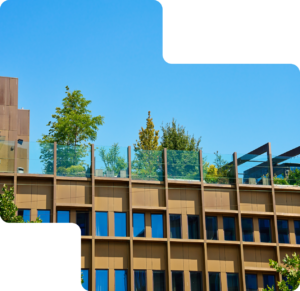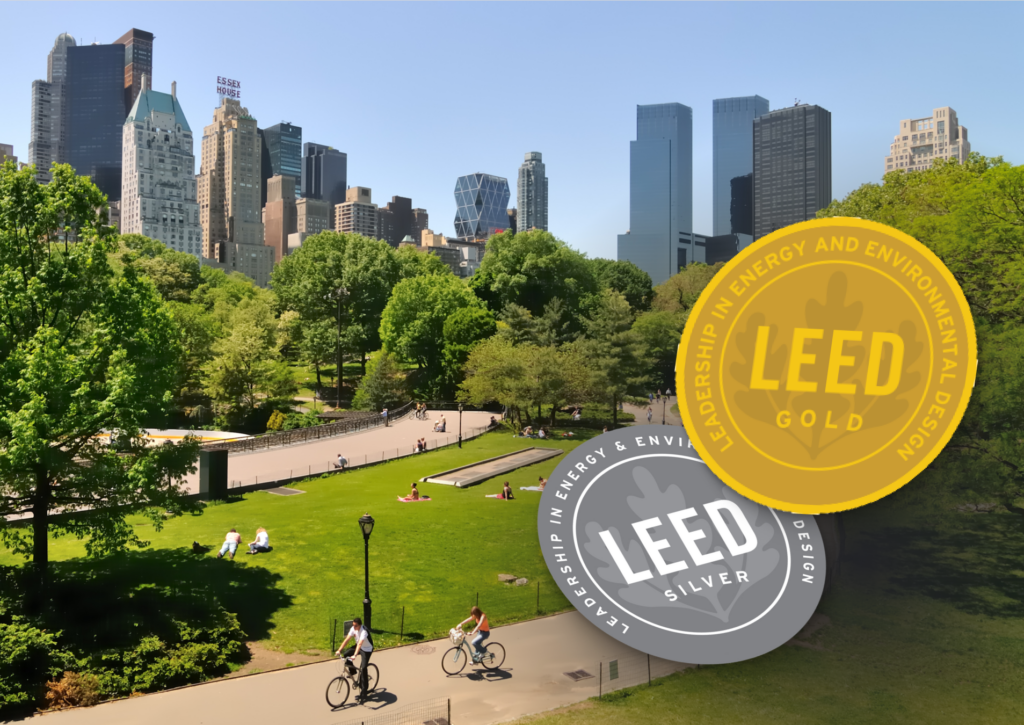“The built environment is a significant contributor to global warming—responsible for up to 40% of carbon emissions.If we want to hit the goals of the Paris Agreement and limit average global temperature gain to below 1.5 degrees Celsius, our buildings need to be part of the solution.”
Anica Landreneau, chair of the LEED Steering Committee USGBC
As climate change, health equity, and sustainable development become more important globally, the built environment is undergoing a profound transformation. One of the most significant drivers of this evolution is the Leadership in Energy and Environmental Design certification system (LEED).
This globally recognized symbol of sustainable development covers almost 200,000 projects in more than 186 countries around the world. Now in its fifth generation, we think the new LEED v5 is a bold reimagining of how buildings should function – not just as structures, but as responsible, regenerative participants in their communities and ecosystems.
 What is LEED v5?
What is LEED v5?
LEED v5 is the latest iteration of the LEED framework for green building practices, reflecting the pressing need for more rigorous climate action, community health, and inclusivity in design. Unlike previous versions that focused largely on energy efficiency and environmental performance, LEED v5 embraces a broader mission: to promote buildings that are sustainable, carbon-conscious, socially equitable, and ecologically restorative. It was developed to respond to both the urgency of climate goals and a growing public demand for healthier, more inclusive spaces.
Launched by the U.S. Green Building Council (USGBC) in the late 1990s, LEED began as a voluntary rating system to encourage environmentally conscious and sustainable design and construction. Over the years, it has grown into a globally recognized framework, influencing more than 29 billion square feet of building projects across nearly every industry.
 Key Changes in LEED v5
Key Changes in LEED v5
We feel the new LEED v5 release stands apart from its predecessors in both scope and ambition. While energy use reduction remains a priority, this version also introduces substantial changes in how performance is measured, verified, and rewarded.
There is a stronger emphasis on decarbonization – both operational and embodied carbon – meaning buildings must now consider their entire climate impact, from construction materials to on-site emissions. As Anica Landreneau puts it:
“The top priority is rapid decarbonization to address the urgency of the climate crisis. Approximately half of the 110 points for achieving LEED v5 certification is based on decarbonization”
Another key shift is the integration of social equity into the rating system. LEED v5 encourages engagement with underserved communities, equitable access to building resources, and thoughtful inclusion in project planning and design. This expansion of LEED’s values is also a turning point in that sustainability is no longer just about the environment, it is also a social function.
 Four Main Pillars of LEED v5
Four Main Pillars of LEED v5
At the core of USGBC LEED v5 are four foundational pillars that define the goals and performance areas for certified projects – decarbonization, quality of life, ecological conservation, and equity
From reducing carbon emissions and enhancing occupant well-being to restoring natural ecosystems and promoting inclusivity, LEED v5 sets a new standard for high-impact, people-centered, and environmentally responsible design.
Pillar One: Decarbonization
Perhaps the most important addition to LEED v5 is a significant focus on carbon emissions across the entire lifecycle of the building. LEED v5 encourages decarbonization through strategies like electrification, the use of low-carbon materials, Scope 3 emissions tracking, energy efficiency, and long-term climate resilience planning.
It does this by requiring projects to implement a 25-year projected carbon assessment, reduce peak load demands of either electric or thermal energy, and implement operational carbon projection & decarbonization plans. Additionally, alongside operational carbon reporting, LEED v5 considers all embodied carbon present within the project, including the emissions generated by materials during manufacturing and transport.
Pillar Two: Quality of Life
LEED v5 places greater emphasis on occupant comfort, air quality, daylight access, and overall wellness to uplift and energize users. From acoustics to mental health benefits through biophilic design, the focus on quality of life ensures that human experience is central to sustainability. Buildings aren’t just places to work or live, they’re spaces that directly influence health and well-being.
Pillar Three: Ecological Conservation and Restoration
This pillar focuses on preserving ecosystems during construction, minimizing site disruption, and restoring damaged landscapes. LEED v5 encourages the use of native vegetation, efficient water management, and strategies to enhance biodiversity. Stormwater systems, pollinator habitats, and ecological buffers are examples of features supported under this pillar. The idea is simply that buildings should be allies of the environment, not adversaries. Protecting nature is not just a side benefit of green building, it’s essential.
Pillar Four: Equity
Perhaps the most striking aspect of LEED v5 is its firm commitment to equity and inclusion. Sustainable buildings should serve everyone, regardless of income, ability, or background. This supports meaningful community engagement, accessible design, and social programming that meets the needs of all users.
 Getting Started with LEED v5
Getting Started with LEED v5
Pursuing LEED v5 certification involves a structured process beginning with project registration using the LEED Online platform. Once registered, teams identify the applicable rating system and then begin compiling documentation for credits that demonstrate compliance with criteria.
The certification journey includes a preliminary review, where USGBC reviewers assess the submitted evidence and request clarifications if needed. Once revisions are complete, the project undergoes a final review before being awarded a certification level – Certified, Silver, Gold, or Platinum. To assist with this process, USGBC provides detailed reference guides, interactive scorecards, and modeling tools.
Real-world examples of LEED v5 adoption are already emerging. From hospitals that prioritize patient wellness and community engagement to commercial campuses that restore native habitats while running on 100% renewable energy, these pilot projects highlight what’s possible when sustainability and innovation converge.
 Benefits of LEED v5 Certification
Benefits of LEED v5 Certification
At RTS, we believe that beyond the prestige of certification, LEED v5 delivers tangible value. Certified projects often report lower utility costs thanks to efficient energy and water systems. Buildings designed with wellness in mind see improved productivity, reduced absenteeism, and higher satisfaction among occupants. 74% of owners and architects believe that green/healthy buildings are more valuable assets than regular buildings.
There’s also market value – green-certified buildings attract tenants, employees, and investors looking for long-term performance and sustainability leadership. 87% of tenants and 47% of retailers want healthy buildings, and occupancy levels of green-certified buildings are approximately 10–18% higher. As more governments and companies commit to environmental, social, and governance (ESG) targets, LEED certified buildings become a vital tool for demonstrating climate accountability and social impact.
The health benefits are also obvious for all to see. The move to green buildings resulted in 30% fewer asthma, respiratory allergies and sick building symptoms in high-performing, green certified buildings.
 The Future of Sustainable Building with LEED v5
The Future of Sustainable Building with LEED v5
LEED v5 reflects a broad shift. No longer is sustainability just about reducing harm, it’s also about actively regenerating our built environment. As cities adapt to climate risks, housing shortages, and public health concerns, we think that buildings that embrace LEED v5’s pillars will be better equipped to serve both people and the planet.
LEED’s influence is expected to grow, with v5 serving as a foundation for even more integrated and performance-based standards. Whether you’re designing a single home or planning an entire urban district, LEED v5 offers a guide to a resilient and carbon-free future.
Conclusion
“Achieving LEED certification is more than just implementing sustainable practices. It represents a commitment to making the world a better place and influencing others to do better.”
Peter Templeton, CEO at the USGBC
We think that LEED v5 isn’t just a new version, it’s an entirely new vision. With its clear focus on decarbonization, quality of life, ecological stewardship, and equity, it is redefining what sustainable building means. As we all strive to create spaces that serve both humanity and the environment, LEED v5 offers the guidance and inspiration to build not just better buildings – but a better world.
Sources
Clairify. (n.d.). How healthy buildings affect commercial real estate. Clairify. Retrieved April 11, 2025, from https://blog.clairify.io/en/how-healthy-buildings-affect-commercial-real-estate
Construction21. (n.d.). Water management: Sustainable solutions that flow naturally. https://www.construction21.org/articles/h/water-management-sustainable-solutions-that-flow-naturally.html
GBCI. (2024, February 5). Top 10 countries and regions for LEED in 2024 show momentum for existing building projects. https://www.gbci.org/top-10-countries-and-regions-leed-2024-show-momentum-existing-building-projects
Green Building Law Update. (2024, November 15). Transforming the built environment: LEED hits 29 billion square feet. https://www.greenbuildinglawupdate.com/2024/11/articles/leed/transforming-the-built-environment-leed-hits-29-billion-square-feet/
Myclimate. (n.d.). What does decarbonisation mean? Retrieved April 11, 2025, from https://www.myclimate.org/en/information/faq/faq-detail/what-does-decarbonisation-mean/
Nature Conservancy. (n.d.). Recommended practices for ecological buffers in shale development. https://www.nature.org/media/centralapps/recommended-shale-practices-ecological-buffers.pdf
RTS. (n.d.). What is LEED certification? Retrieved April 11, 2025, from https://www.rts.com/resources/guides/what-is-leed-certification/
RTS. (n.d.). LEED certified buildings: A guide to benefits and process. Retrieved April 11, 2025, from https://www.rts.com/blog/leed-certified-buildings/
U.S. Environmental Protection Agency. (n.d.). Building air quality: A guide for building owners and facility managers. https://www.epa.gov/indoor-air-quality-iaq/building-air-quality-guide-guide-building-owners-and-facility-managers
U.S. Green Building Council. (n.d.). LEED. https://www.usgbc.org/leed
U.S. Green Building Council. (n.d.). LEED v5. https://www.usgbc.org/leed/v5
U.S. Green Building Council. (n.d.). Top 10 countries for LEED in 2023. https://www.usgbc.org/top-10-leed-2023
U.S. Green Building Council. (2024, October 25). USGBC members approve release of LEED v5. https://www.usgbc.org/articles/usgbc-members-approve-release-leed-v5
U.S. Green Building Council. (n.d.). Homepage. https://www.usgbc.org/
U.S. General Services Administration. (n.d.). Sustainable design. https://www.gsa.gov/real-estate/design-and-construction/sustainability/sustainable-design
Canada Green Building Council. (2025, March). Unlocking the value of green building. https://www.cagbc.org/wp-content/uploads/2025/03/CAGBC-Unlocking-the-value-of-green-building.pdf

